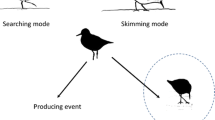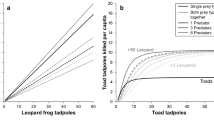Abstract
I examined the effect of competitor density on foraging success in staging semipalmated sandpipers (Calidris pusilla) foraging on a burrowing amphipod (Corophium volutator) in each of two study years. Little is known about the effect of competitor density when predation attempts disturb prey, causing a temporary decrease in food availability. Controlling for Corophium density and other potentially confounding factors such as temperature, pecking rate and capture rate increased linearly with sandpiper density. Success rate, the ratio of captures to pecks, was not influenced by sandpiper density. The effect of sandpiper density was similar in each of the two study years and was documented early and late in the low tide period. The increase in foraging rate is argued to be a response to increased competition for rapidly depleting prey at the temporal scale of exploitation by a flock. Potential fitness costs associated with higher foraging costs may include decreased ability to distinguish between the profitability of different prey and reduced vigilance against predators.

Similar content being viewed by others
References
Battley PF, Poot M, Wiersma P, Gordon C, Ntiamoa-Baidu Y, Piersma T (2003) Social foraging by waterbirds in shallow coastal lagoons in Ghana. Waterbirds 26:26–34
Beauchamp G (1998) The effect of group size on mean food intake rate in birds. Biol Rev 73:449–472
Beauchamp G (2005) Low foraging success of Semipalmated Sandpipers at the edges of groups. Ethology 111:785–798
Beauchamp G (2006) Spatial, temporal and weather factors influencing the foraging behavior of migrating Semipalmated Sandpipers. Waterbirds 29:221–225
Bednekoff PA, Lima SL (2005) Testing for peripheral vigilance: do birds value what they see when not overtly vigilant? Anim Behav 69:1165–1171
Blumstein DT, Evans CS, Daniel JC (1999) An experimental study of behavioural group size effects in tammar wallabies, Macropus eugenii. Anim Behav 58:351–360
Boates JS (1980) Foraging semipalmated sandpipers Calidris pusilla L. and their major prey Corophium volutator (Pallas) on the Starrs Point mudflat Minas Basin. Acadia University, Wolfville, NS, Canada
Caraco T (1979) Time budgeting and group size: a test of theory. Ecology 60:618–627
Clark CW, Mangel M (1986) The evolutionary advantages of group foraging. Theor Popul Biol 30:45–75
Crewe TL, Hamilton DJ, Diamond AW (2001) Effects of mesh size on sieved samples of Corophium volutator. Estuar Coast Shelf Sci 53:151–154
Dehn MM (1990) Vigilance for predators: detection and dilution effects. Behav Ecol Sociobiol 26:337–342
Elgar MA (1989) Predator vigilance and group size in mammals and birds. Biol Rev 64:13–33
Evans PR (1976) Energy balance and optimal foraging in shorebirds: some implications for their distributions and movements in the non-breeding season. Ardea 64:117–139
Foster WA, Treherne JE (1981) Evidence for the dilution effect in the selfish herd from fish predation on a marine insect. Nature 293:466–467
Goss-Custard JD (1976) Variation in the dispersion of redshank Tringa totanus on their winter feeding grounds. Ibis 118:257–263
Goss-Custard JD (1980) Competition for food and interference among waders. Ardea 68:31–52
Goss-Custard JD et al. (2006) Intake rates and the functional response in shorebirds (Charadriiformes) eating macro-invertebrates. Biol Rev 81:501–529
Gratto GW, Thomas MLT, Gratto CL (1984) Some aspects of the foraging ecology of migrant juvenile sandpipers in the outer Bay of Fundy. Can J Zool 62:1889–1892
Hamilton DJ, Barbeau MA, Diamond AW (2003) Shorebirds, mud snails, and Corophium volutator in the upper Bay of Fundy, Canada: predicting bird activity on intertidal mud flats. Can J Zool 81:1358–1366
Hamilton DJ, Diamond AW, Wells PG (2006) Shorebirds, snails, and the amphipod (Corophium volutator) in the upper Bay of Fundy: top–down vs. bottom–up factors, and the influence of compensatory interactions on mudflat ecology. Hydrobiologia 567:285–306
Hicklin PW (1987) The migration of shorebirds in the Bay of Fundy. Wilson Bull 99:540–570
Hicklin PW, Smith PC (1979) The diets of five species of migrant shorebirds in the Bay of Fundy. Proc N S Inst Sci 29:483–488
Krause J, Ruxton GD (2002) Living in groups. Oxford University Press, Oxford
MacDonald PRN (1987) Comparative feeding ecology and behaviour of migrating adult least (Calidris minutilla (Viellot)) and semipalmated (C. pusilla (Linnaeus)) sandpipers in the Southern Bight, Minas Basin, NS. MS thesis, Acadia University, Wolfville, NS, Canada
Minderman J, Lind J, Cresswell W (2006) Behaviourally mediated indirect effects: interference competition increases predation mortality in foraging redshanks. J Anim Ecol 75:713–723
Morrison RIG, Downes C, Collins B (1994) Population trends of shorebirds on fall migration in Eastern Canada 1974–1991. Condor 106:431–447
Nebel S, Thompson GJ (2005) Foraging behaviour of western sandpipers changes with sediment temperature: implications for their hemispheric distribution. Ecol Res 20:503–507
Norris K, Johnstone I (1998) Interference competition and the functional response of oystercatchers searching for cockles by touch. Anim Behav 56:639–650
Peer DL, Linkletter LE, Hicklin PW (1986) Life history and reproductive biology of Corophium volutator (Crustacea, Amphipoda) and the influence of shorebird predation on population structure in Chignecto Bay, Bay of Fundy, Canada. Neth J Sea Res 20:359–373
Pienkowski MW (1983) Surface activity of some intertidal invertebrates in relation to temperature and the foraging behaviour of their shorebird predators. Mar Ecol Prog Ser 11:141–150
Proctor CJ, Broom M, Ruxton GD (2003) A communication-based spatial model of antipredator vigilance. J Theor Biol 220:123–137
Pulliam HR (1973) On the advantages of flocking. J Theor Biol 38:419–422
Saino N (1994) Time budget variation in relation to flock size in carrion crows, Corvus corone corone. Anim Behav 47:1189–1196
Selman J, Goss-Custard JD (1988) Interference between foraging redshanks Tringa totanus. Anim Behav 36:1542–1544
Shaw JJ, Tregenza T, Parker GA, Harvey IF (1995) Evolutionarily stable foraging speeds in feeding scrambles: a model and an experimental test. Proc R Soc Lond B 260:273–277
Shepherd PCF, Boates JS (1999) Effects of a commercial baitworm harvest on Semipalmated Sandpipers and their prey in the Bay of Fundy hemispheric shorebird reserve. Conserv Biol 13:347–356
Stillman RA, Bautista LM, Alonso JC, Alonso JA (2002) Modelling state-dependent interference in common cranes. J Anim Ecol 71:874–882
Stillman RA, Goss-Custard JD, Alexander MJ (2000) Predator search pattern and the strength of interference through prey depression. Behav Ecol 11:597–605
Sutherland WJ (1996) From individual behaviour to population ecology. Oxford University Press, Oxford
Triplet P, Stillman RA, Goss-Custard JD (1999) Prey abundance and the strength of interference in a foraging shorebird. J Anim Ecol 68:254–265
Vahl WK, van der Meer J, Weissing FJ, van Dullemen D, Piersma T (2005) The mechanisms of interference competition: two experiments on foraging waders. Behav Ecol 16:845–855
Wilson WH (1990) Relationship between prey abundance and foraging site selection by semipalmated sandpipers on a Bay of Fundy mudflat. J Field Ornithol 61:9–19
Yates MG, Stillman RA, Goss-Custard JD (2000) Contrasting interference functions and foraging dispersion in two species of shorebird (Charadrii). J Anim Ecol 69:314–322
Acknowledgments
The author thanks C. McKinnon for permission to work at Mary’s Point, and two anonymous referees for their useful comments.
Author information
Authors and Affiliations
Corresponding author
Additional information
Communicated by Scott Robinson.
Rights and permissions
About this article
Cite this article
Beauchamp, G. Competition in foraging flocks of migrating semipalmated sandpipers. Oecologia 154, 403–409 (2007). https://doi.org/10.1007/s00442-007-0818-8
Received:
Accepted:
Published:
Issue Date:
DOI: https://doi.org/10.1007/s00442-007-0818-8




